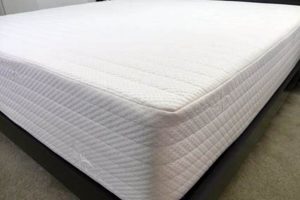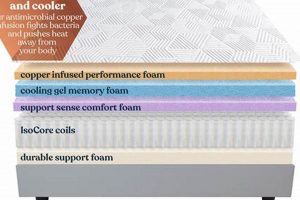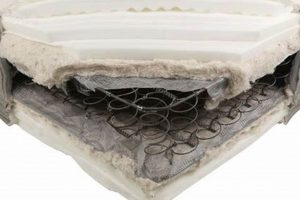Analysis of consumer feedback regarding Tempur-Pedic mattresses is crucial for prospective buyers. These assessments, often found online, provide valuable insights into the performance, durability, and overall satisfaction associated with different models. A review typically encompasses various aspects, including comfort level, support, temperature regulation, and motion isolation. These collective experiences form a crucial resource for understanding the products strengths and weaknesses.
The significance of evaluating user opinions lies in their ability to offer a realistic portrayal beyond marketing materials. They provide a more holistic understanding of long-term performance and potential issues. Examining trends within the available commentary helps to identify consistent positives or negatives, facilitating a more informed purchasing decision. The availability of such consumer-generated content has also influenced product development and improvement within the mattress industry.
This exposition will delve into the key factors considered within these evaluations, common themes that emerge, and guidance on how to effectively utilize such information when selecting a Tempur-Pedic mattress. It will examine aspects like material science and its impact on sleep quality as evidenced by aggregated user reports.
Guidance Derived from User Feedback on Tempur-Pedic Mattresses
The following recommendations are based on recurring themes and observations found within accumulated Tempur-Pedic mattress reviews. These insights are intended to aid in the selection process.
Tip 1: Evaluate Firmness Preferences Critically: User opinions frequently highlight discrepancies between perceived firmness levels in showrooms and actual experience at home. Consider a slightly firmer model if unsure, as Tempur-Pedic materials tend to soften with use.
Tip 2: Assess Temperature Sensitivity: Individuals sensitive to temperature fluctuations should pay close attention to evaluations discussing heat retention. Some users report certain models sleep warmer than others. Look for reviews explicitly addressing temperature regulation performance.
Tip 3: Scrutinize Motion Isolation Claims: A primary selling point of Tempur-Pedic mattresses is motion isolation. Analyze assessments from couples regarding disturbance caused by partner movement. Verify the degree of isolation meets individual needs.
Tip 4: Consider the Break-In Period: Numerous evaluations mention an initial break-in period where the mattress feels firmer than expected. Factor this into the assessment and allow adequate time for the material to conform before making a final judgment.
Tip 5: Examine Edge Support Critiques: Some user accounts detail issues with edge support, particularly along the perimeter. If edge support is a priority (e.g., for those who sit on the edge of the bed), carefully review commentary specifically addressing this aspect.
Tip 6: Validate Warranty and Return Policies: Before purchase, meticulously review the terms of the warranty and return policy. Understand the stipulations for returns and potential associated costs, as user experience varies regarding the ease of these processes.
Tip 7: Compare Models Across Multiple Sources: Do not rely on a single review source. Aggregate information from various platforms to obtain a comprehensive understanding of a specific mattress model’s strengths and weaknesses.
In summary, careful consideration of collective user experiences provides valuable insights into the potential performance and suitability of Tempur-Pedic mattresses. Focusing on the aforementioned tips enhances the likelihood of a satisfactory purchase.
The next section will explore common misconceptions associated with purchasing these mattresses.
1. Firmness Perception
Firmness perception constitutes a critical dimension within Tempur-Pedic mattress reviews, frequently determining overall user satisfaction. The subjective nature of firmness implies that individual interpretations often vary significantly, leading to divergent opinions within gathered commentary. Discrepancies arise from factors such as body weight, sleeping position, and pre-existing preferences. A review describing a mattress as “firm” may be perceived as “medium” by another individual due to differing physical attributes or expectations. This variability necessitates careful analysis of multiple reviews to discern a pattern rather than relying on isolated assessments.
The material composition of Tempur-Pedic mattresses, primarily viscoelastic foam, contributes to the complexity of firmness perception. The foam’s responsiveness to temperature and pressure means that firmness can fluctuate throughout the night. A mattress may initially feel firmer upon lying down but gradually soften as the material conforms to the body’s contours. This dynamic property creates challenges for reviewers attempting to provide a static assessment of firmness. Furthermore, different Tempur-Pedic models employ varying densities and layer constructions, influencing the overall firmness profile. Evaluating specific models, such as the LuxeAdapt or ProAdapt, demonstrates the impact of these material differences on perceived firmness, emphasizing the need to consider reviews pertaining to particular models.
Therefore, understanding the inherent subjectivity of firmness and considering the dynamic properties of Tempur-Pedic materials is crucial when interpreting user reviews. A comprehensive analysis of multiple sources, coupled with an awareness of individual physical characteristics and preferences, mitigates the risk of misinterpreting firmness assessments. The focus shifts from seeking universally applicable statements about firmness to identifying patterns that align with individual needs, underscoring the importance of detailed comparative analysis.
2. Temperature Regulation
Temperature regulation constitutes a significant factor in Tempur-Pedic mattress reviews. The inherent properties of viscoelastic foam, a primary component in these mattresses, often lead to heat retention. This characteristic can negatively affect sleep quality for individuals prone to night sweats or those residing in warmer climates. Consequently, consumer feedback frequently addresses the mattress’s ability to maintain a comfortable sleeping temperature. Reviews indicating excessive heat buildup often reflect dissatisfaction, influencing overall product ratings. Conversely, mattresses designed with enhanced airflow or cooling technologies typically receive positive assessments regarding thermal performance. The presence or absence of effective temperature regulation directly impacts perceived comfort and, subsequently, the overall score within Tempur-Pedic mattress reviews.
The impact of temperature regulation is exemplified by the con
trasting experiences documented in reviews of different Tempur-Pedic models. Older models lacking advanced cooling features commonly receive criticism for sleeping “hot.” In contrast, newer models incorporating materials such as phase-change infusions or ventilated foam layers often garner praise for improved thermal management. The implementation of these technologies aims to mitigate heat retention, leading to more favorable reviews. Furthermore, the effectiveness of external factors like bedding materials and room temperature can influence the subjective experience of temperature regulation. Reviews often mention the use of breathable sheets or climate control measures to counteract potential heat buildup, highlighting the interplay between mattress design and environmental conditions. These testimonials demonstrate the practical relevance of understanding temperature regulation as a key determinant of satisfaction with Tempur-Pedic mattresses.
In summary, temperature regulation constitutes a pivotal aspect of consumer assessments of Tempur-Pedic mattresses. The inherent thermal properties of viscoelastic foam necessitate careful consideration of design features aimed at mitigating heat retention. By examining review trends and identifying models that effectively manage temperature, prospective buyers can make more informed decisions. The challenge lies in interpreting subjective feedback and understanding how individual preferences and environmental factors contribute to the overall thermal experience. Ultimately, analyzing temperature regulation within Tempur-Pedic mattress reviews provides valuable insights into the potential for comfortable sleep.
3. Motion Isolation
Motion isolation, a prominent characteristic in mattress design, significantly influences user evaluations found in Tempur-Pedic mattress reviews. This attribute refers to a mattress’s ability to minimize the transfer of movement from one area to another. Consequently, disturbances caused by a sleeping partner’s tossing and turning are reduced, promoting uninterrupted sleep for both individuals. Reviews frequently highlight motion isolation as a key benefit, particularly for couples or individuals sharing a bed with restless sleepers. Positive assessments in this area often contribute to higher overall ratings. The degree of motion isolation achieved directly impacts sleep quality and satisfaction, making it a critical consideration within Tempur-Pedic mattress reviews. Instances of users specifically praising the lack of disturbance from a partner entering or exiting the bed exemplify the practical significance of this feature.
The viscoelastic foam used in Tempur-Pedic mattresses inherently possesses excellent motion isolation properties. This material absorbs and dissipates energy, preventing movement from propagating across the sleeping surface. However, variations in foam density and mattress construction can affect the level of motion isolation achieved. Reviews often differentiate between models, indicating that certain designs offer superior isolation compared to others. The effectiveness of motion isolation also interacts with other mattress characteristics, such as firmness. A firmer mattress may transfer more motion than a softer one, even when constructed with the same type of foam. This interplay underscores the importance of considering multiple factors when interpreting Tempur-Pedic mattress reviews. Furthermore, external factors, such as the type of bed frame used, can influence the perceived level of motion isolation.
In conclusion, motion isolation plays a vital role in shaping consumer perceptions of Tempur-Pedic mattresses, as evidenced by the content found in user reviews. The effectiveness of motion isolation directly influences sleep quality and overall satisfaction, particularly for couples. While viscoelastic foam inherently provides good motion isolation, variations in mattress design and construction can lead to differences in performance. Analyzing Tempur-Pedic mattress reviews with a focus on motion isolation allows prospective buyers to make informed decisions based on their individual sleep needs and preferences. Addressing the subjective nature of review content alongside objective measures of foam density aids in achieving the desired outcome.
4. Durability Concerns
Durability represents a critical attribute evaluated within Tempur-Pedic mattress reviews. The long-term performance and lifespan of these mattresses directly influence user satisfaction and perceived value. Reports of premature degradation or loss of support can significantly impact overall ratings and consumer sentiment.
- Sagging and Impression Formation
A prevalent concern within reviews relates to sagging and the formation of permanent impressions. While viscoelastic foam conforms to the body, persistent compression can lead to localized deformation over time. Reviews often document instances of noticeable sagging in high-pressure areas, such as the hips or shoulders. This degradation reduces support and comfort, negatively affecting sleep quality. The extent of sagging reported varies based on mattress model, user weight, and sleeping habits.
- Loss of Firmness and Support
Another recurring theme involves a gradual loss of firmness and support. Users report that mattresses initially providing adequate support may soften excessively over several years. This reduction in support can lead to back pain and discomfort. Reviews frequently mention the degradation of the foam’s responsiveness and its ability to maintain proper spinal alignment. The rate of firmness loss is influenced by factors such as usage frequency and environmental conditions.
- Edge Support Deterioration
Edge support, the firmness along the mattress perimeter, is another area of concern documented in reviews. Users report that edge support can weaken over time, particularly in mattresses lacking reinforced edges. This deterioration makes it difficult to sit or sleep near the edge of the bed. Reduced edge support also compromises the usable surface area of the mattress. Reports of edge collapse are often accompanied by complaints of instability and difficulty getting in and out of bed.
- Material Degradation and Off-Gassing
Reviews occasionally mention issues related to material degradation, such as crumbling or cracking of the foam. These instances, although less frequent, raise concerns about the overall quality and longevity of the mattress. Furthermore, some users report prolonged off-gassing, the release of volatile organic compounds, from the foam. While off-gassing typically diminishes over time, persistent odors can cause discomfort and health concerns for sensitive individuals.
The aforementioned durability concerns underscore the importance of scrutinizing long-term user experiences when evaluating Tempur-Pedic mattresses. Examining review trends and identifying recurring issues provides valuable insights into the potential lifespan and performance of specific models. Considering factors such as user weight, sleeping habits, and environmental conditions can further refine the assessment of durability-related feedback. Furthermore, comparison of these reviews to the terms of the product warranty provides valuable information regarding manufacturer support and consumer protection. All of this leads to a more informed purchasing decision.
5. Edge Support Quality
Edge support quality is a recurring theme within Tempur-Pedic mattress reviews, often influencing overall customer satisfaction. The perimeter of a mattress, if inadequately supported, can lead to a feeling of instability, particularly when sitting on the edge or sleeping near it. Consequently, reviews frequently address the degree to which the mattress maintains its structural integrity along its borders. Insufficient edge support can cause a roll-off sensation, diminishing the usable sleeping surface and creating discomfort. Consider, for instance, a user who routinely sits on the edge of their bed to put on shoes; inadequate support can result in a noticeable sinking feeling, negatively impacting their perception of the mattress’s overall value and functionality. Thus, edge support becomes a significant component in assessing the overall quality and usability of a Tempur-Pedic mattress, directly influencing the tone and substance of consumer evaluations.
The cause-and-effect relationship between edge support and review sentiment is evident in numerous online testimonials. Mattresses with reinforced edges tend to receive more favorable reviews, specifically mentioning the stability and confidence provided when utilizing the entire sleeping surface. Conversely, reviews criticizing edge support often detail instances of premature sagging or collapse along the perimeter, leading to lower ratings and expressions of disappointment. Practical applications of this understanding are particularly relevant for individuals with mobility issues or those sharing a bed, where the availability of consistent support across the entire mattress surface is crucial. These applications highlight how the tangible performance of edge support translates directly into the perceived value and utility reported in mattress reviews.
In summary, edge support quality plays a vital role in shaping the overall tone and content of Tempur-Pedic mattress reviews. It is a key indicator of long-term durability, usable sleeping surface, and the general sense of security and stability provided by the mattress. Addressing this concern effectively in mattress design and manufacturing is critical for maintaining customer satisfaction and garnering positive feedback. The practical significance lies in its direct impact on the user experience, underscoring the need for prospective buyers to carefully evaluate edge support assessments within consumer reports.
6. Long-term Comfort
Long-term comfort forms a crucial cornerstone of Tempur-Pedic mattress reviews. While initial impressions influence immediate satisfaction, the sustained comfort experienced over months and years dictates the overall value proposition. Reviews often highlight the dichotomy between initial firmness and the eventual softening of the mattress, a factor directly influencing long-term comfort. A mattress perceived as initially ideal may, over time, develop impressions or lose support, leading to diminished comfort and negative feedback. Conversely, a slightly firmer initial feel might yield superior long-term comfort as the material conforms without significant degradation. Reports detailing back pain alleviation or improved sleep quality after extended use underscore the significance of long-term comfort as a pivotal element within Tempur-Pedic mattress reviews. Therefore, assessing long-term comfort is vital for discerning the true value of a Tempur-Pedic mattress.
Practical examples derived from user commentary illustrate the nuanced nature of long-term comfort. Individuals with chronic pain conditions frequently report on the sustained pressure relief provided by Tempur-Pedic mattresses, highlighting the viscoelastic foam’s ability to contour to the body. However, other users express dissatisfaction with the gradual loss of support, resulting in discomfort and exacerbation of existing conditions. The impact of body weight, sleeping position, and mattress maintenance practices further influences long-term comfort. Reviews often mention the importance of rotating the mattress to distribute wear evenly and prolong its lifespan. Moreover, the correlation between perceived long-term comfort and mattress age is often discussed, with many users offering insights into how their experience evolved over several years.
In conclusion, long-term comfort emerges as a dominant theme in Tempur-Pedic mattress reviews, shaping consumer perceptions and influencing purchasing decisions. The sustained performance of the mattress, its ability to maintain support and alleviate pressure points over extended periods, directly translates to user satisfaction. While initial impressions matter, the true test of a Tempur-Pedic mattress lies in its capacity to provide consistent comfort and support throughout its lifespan. Evaluating reviews that emphasize long-term experiences offers valuable insights for prospective buyers seeking a lasting investment in their sleep health. This analysis mitigates the risks associated with relying solely on short-term assessments, fostering a more informed and discerning approach to mattress selection.
7. Value Proposition
The value proposition of a Tempur-Pedic mattress, as reflected in consumer reviews, hinges on the perceived balance between price, performance, and longevity. Reviews frequently assess whether the premium cost aligns with the reported benefits, such as enhanced sleep quality, pain relief, and durability. Discrepancies between expectations and actual experiences directly impact the perceived value. For example, a user expecting exceptional motion isolation and pressure relief, based on marketing claims, might deem the purchase unsatisfactory if real-world performance falls short, regardless of the mattress’s initial cost. Conversely, individuals reporting significant improvements in sleep and reduced back pain, despite the high price, often view the mattress as a worthwhile investment. Therefore, the value proposition, as derived from reviews, is intrinsically linked to the individual’s assessment of whether the product delivers on its promises.
Analyses of “tempur-pedic mattress reviews” highlight the diverse perspectives on the product’s value. Some consumers focus primarily on durability, expecting a longer lifespan commensurate with the higher price point. Reports of sagging or premature wear can significantly diminish the perceived value, even if the mattress initially provided exceptional comfort. Other consumers prioritize specific features, such as temperature regulation or motion isolation, and assess the value based on the effectiveness of these attributes. For instance, a hot sleeper may find the higher price of a Tempur-Pedic mattress with cooling technology justified if it demonstrably reduces nighttime overheating. Real-world examples of this include users specifically citing the impact of the cooling features on their ability to achieve restful sleep as a significant factor in their value assessment. Similarly, couples often emphasize motion isolation, with positive reviews highlighting the lack of disturbance from a partner’s movements as a key determinant of value.
In conclusion, the value proposition, as conveyed through reviews, is a complex and multifaceted construct. It encompasses not only the objective attributes of the mattres
s, such as its construction and features, but also the subjective experiences and expectations of the individual user. Understanding the interplay between these factors is crucial for both prospective buyers and the manufacturer. By carefully analyzing review trends and identifying the key determinants of perceived value, consumers can make more informed purchasing decisions, while manufacturers can gain valuable insights into how to optimize their products and marketing strategies to better meet customer needs and expectations.
Frequently Asked Questions Regarding Tempur-Pedic Mattress Assessments
The following section addresses common inquiries arising from analysis of Tempur-Pedic mattress evaluations. These responses aim to provide clarity and facilitate informed decision-making.
Question 1: What is the primary source of information for “tempur-pedic mattress reviews?”
User-generated content across various platforms constitutes the primary source. These include online retailers’ review sections, independent review websites, and consumer forums. Compilation and analysis of this data provide a comprehensive overview of product performance.
Question 2: How should conflicting reviews be interpreted?
Conflicting reviews are inherent due to individual preferences and varying circumstances. Patterns and trends, rather than isolated opinions, should be prioritized. Factors such as body weight, sleeping position, and pre-existing health conditions influence individual experiences.
Question 3: Is the firmness rating provided by the manufacturer reliable?
Manufacturer firmness ratings offer a general guideline, but individual perception may differ. Consumer assessments often reveal discrepancies between stated and perceived firmness levels. Cross-referencing manufacturer ratings with user feedback is recommended.
Question 4: What factors contribute to heat retention in Tempur-Pedic mattresses?
The density of viscoelastic foam, a primary component, contributes to heat retention. Models incorporating cooling technologies aim to mitigate this effect. Individual sensitivity to temperature also influences the perception of heat buildup.
Question 5: How can the validity of a review be assessed?
Look for detailed descriptions, specific examples, and a balanced perspective. Reviews lacking specifics or exhibiting extreme bias should be approached with caution. Verifying the reviewer’s history or profile, when available, can offer additional context.
Question 6: What role does the warranty play in addressing durability concerns highlighted in Tempur-Pedic mattress reviews?
The warranty provides recourse for specific defects or premature degradation, as defined by the manufacturer. Understanding the terms and conditions is crucial. However, the warranty may not cover subjective comfort preferences or normal wear and tear.
In summary, thorough analysis of “tempur-pedic mattress reviews” necessitates a critical approach, considering the inherent subjectivity and variability of consumer experiences. Identifying patterns, cross-referencing information, and understanding the limitations of available data are essential for informed decision-making.
The subsequent section will explore strategies for mitigating potential risks associated with Tempur-Pedic mattress purchases.
Conclusion
Analysis of “tempur-pedic mattress reviews” reveals a complex landscape of user experiences, influenced by subjective preferences and objective product characteristics. Firmness perception, temperature regulation, motion isolation, durability concerns, edge support quality, long-term comfort, and value proposition emerge as pivotal themes. Discrepancies in user feedback necessitate a discerning approach, prioritizing pattern recognition over isolated opinions. Integrating manufacturer specifications with aggregated consumer insights facilitates a more comprehensive assessment.
The purchasing decision regarding a Tempur-Pedic mattress warrants careful deliberation, informed by a thorough understanding of collective user experiences. Scrutinizing “tempur-pedic mattress reviews” provides valuable insights into potential benefits and drawbacks, enabling prospective buyers to align expectations with realistic outcomes. Continued evaluation and refinement of mattress technology, coupled with transparent communication from manufacturers, are essential for fostering trust and ensuring customer satisfaction in the dynamic market of sleep solutions.






![Honest Mattress Firm Adjustable Base Review [2024] & Guide Organic & Natural Mattress Buyer’s Guide: Non-Toxic Sleep Solutions Honest Mattress Firm Adjustable Base Review [2024] & Guide | Organic & Natural Mattress Buyer’s Guide: Non-Toxic Sleep Solutions](https://mattressworldpa.com/wp-content/uploads/2025/07/th-4342-300x200.jpg)
